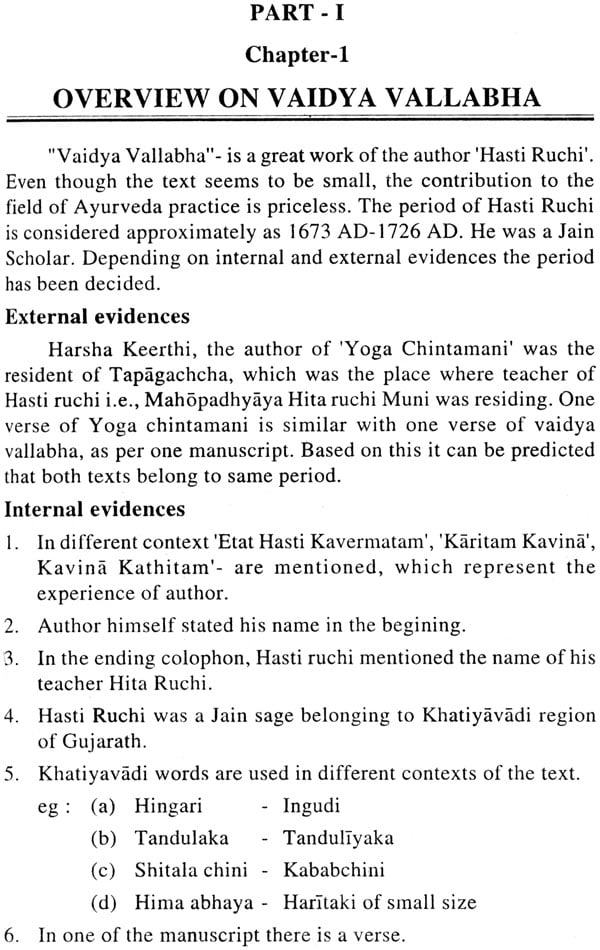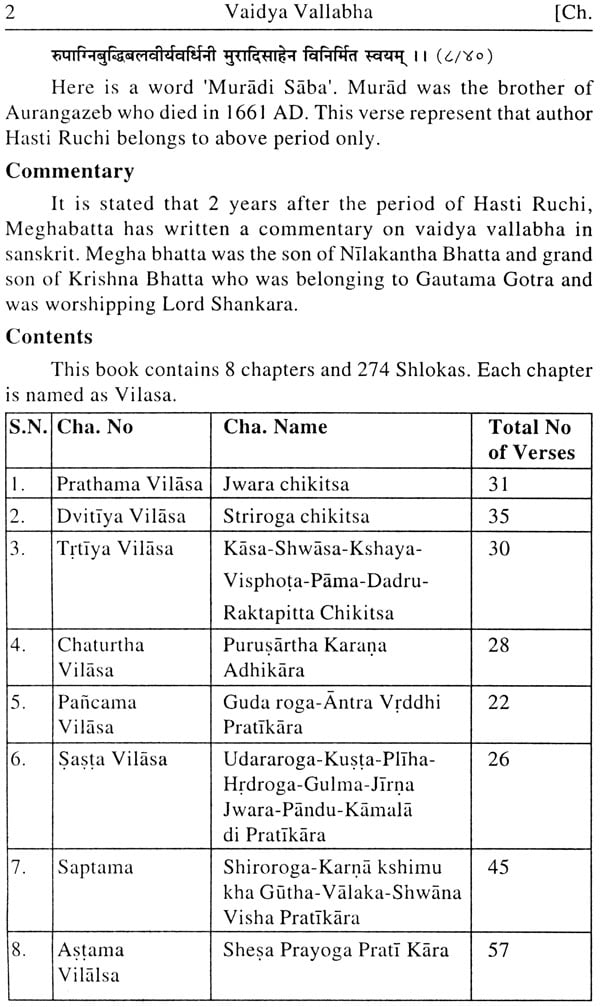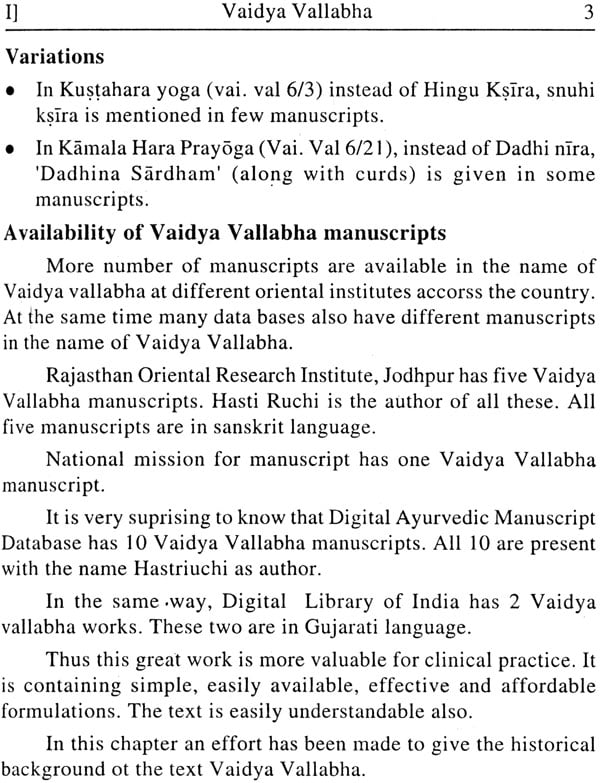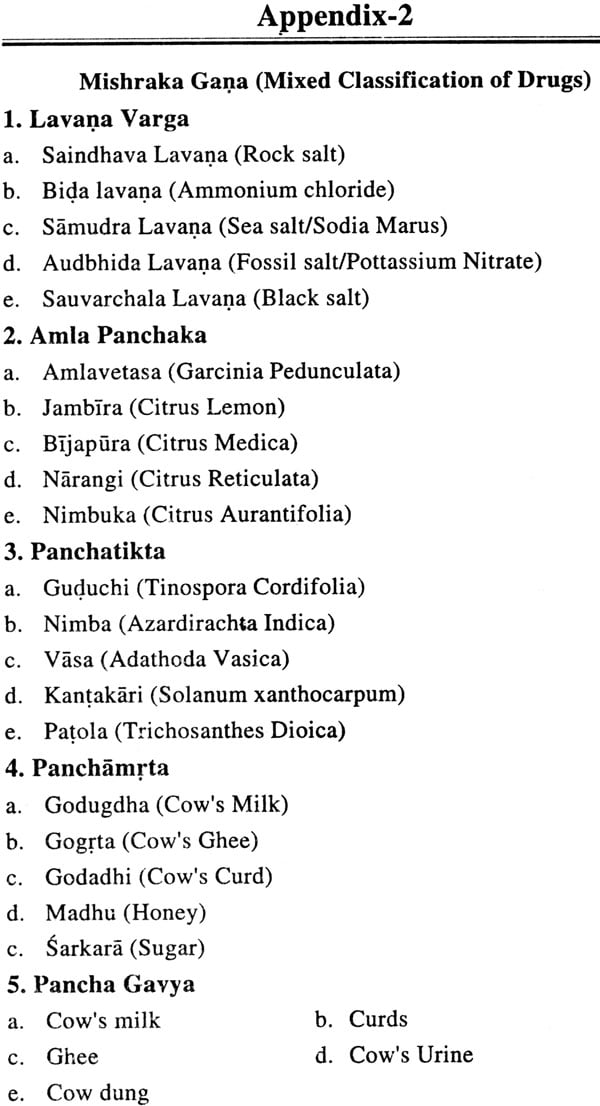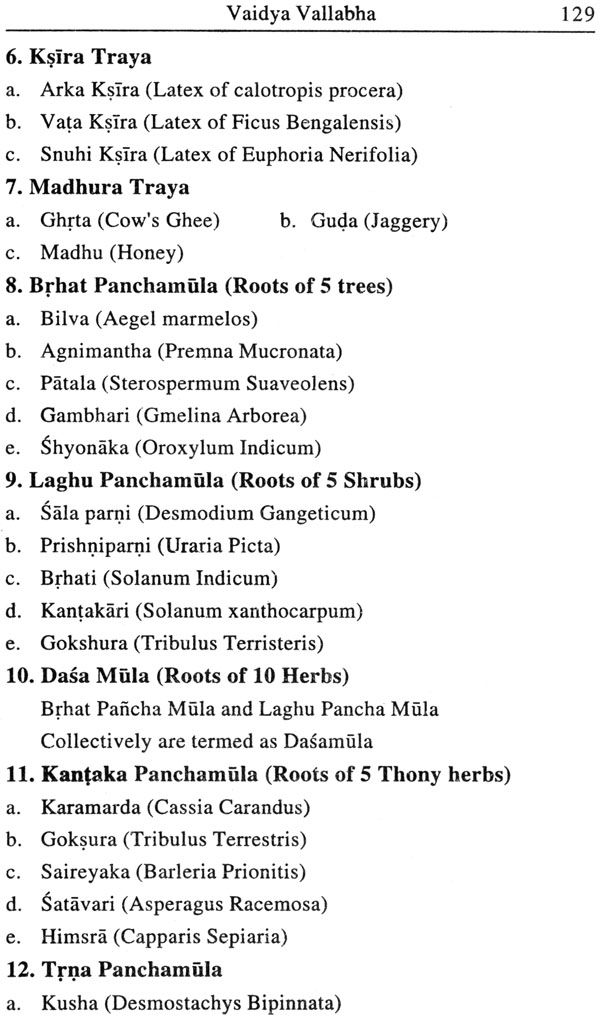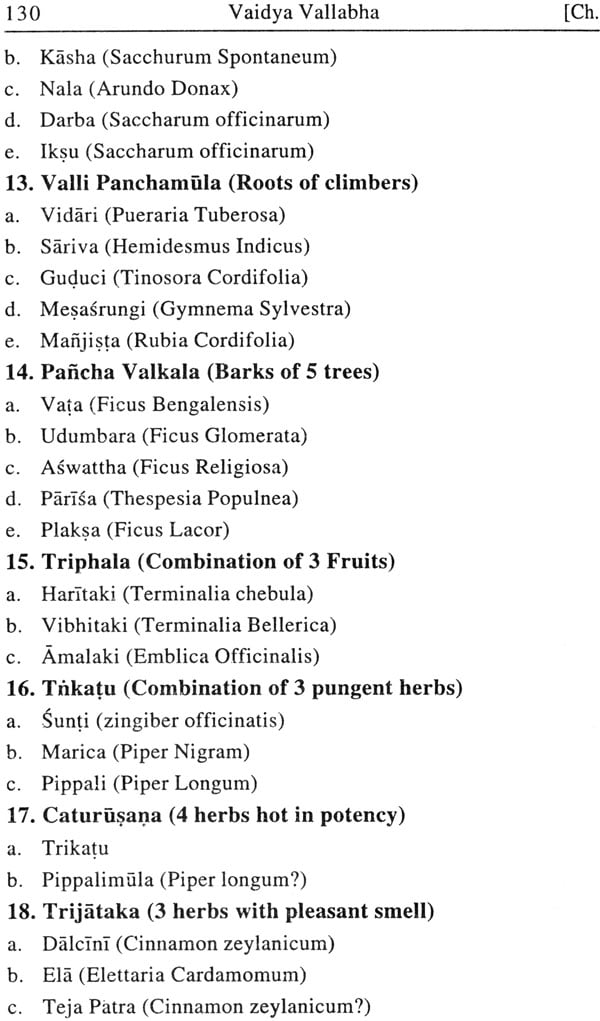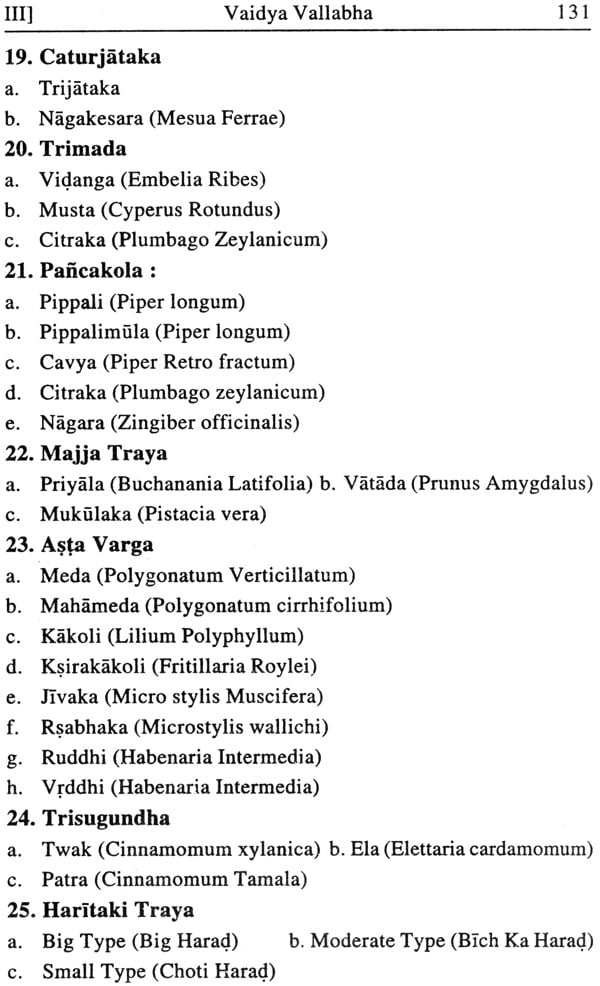
Vaidya Vallabha (Authoritative Scripture on Ayurveda Therapeutics)
Book Specification
| Item Code: | NAL048 |
| Author: | Dr. Shreevathsa and Dr. Arhanth Kumar A. |
| Publisher: | Chaukhambha Orientalia |
| Language: | Sanskrit and English |
| Edition: | 2015 |
| ISBN: | 9788176373487 |
| Pages: | 146 |
| Cover: | Paperback |
| Other Details | 8.5 inch x 5.5 inch |
| Weight | 180 gm |
Book Description
The text "Vaidya Vallabha" written by Hastiruchi, a jain scholar. It is belonging to the time period of 1673 AD 1726 AD. Different physical and mental ailments are addressed in 274 shlokas of 8 chapters. In this text many unique, special and simple medicinal preparations for different diseases are given and it is the highlight of the text.
Many drugs which were easily available in the local area are given much more importance in the treatment. Adding to this, method and uniqueness of naming of the disease in the text stands differently when compared to other texts. This text contains three sections, in the first section overview, glimpses of text "Vaidya Vallabha", medical manuscriptology, and ayurvedic pharmaceutics are explained elaborately. In the second section aetiology, pathogenesis, types, signs, symptoms and treatment of different diseases are narrated in eight chapters. At the end, in the third section posology, mishraka varga and rasa dravyas are explained, which helps to understand the second section very easily.
In total, this work of edited and translated text book of "Vaidya Vallabha" is a sincere effort of the authors which will save the treasure of knowledge of ancient Indian medical heritage. This work definitely enriches the knowledge of all readers, students, physicians, and research scholars of ayurveda fraternity.
Dr. Shreevathsa, basically from Shimoga district, Karnataka state. He is Professor and Head, P.G. Studies in Department of Ayurveda Siddhanta, Govt. Ayurveda Medical College, Mysore. He completed his B.A.M.S. from Govt.
Ayurveda Medical College, Mysore in 1996 with 1st rank. He completed his M.D. (Ayu) from I.P.G.T. & R.A., Gujarat Ayurveda University, Jamnagar in 2000. He is double gold medalist and "Rotary Pandit Ayurvedic Education Awardee". He completed P.G. Diploma in Yoga and Vidwat (P) level in Karnatic music. He is practicing Yoga Chikitsa, Naadachikitsa and Ayurveda Chikitsa. He participated in various National and International seminars as resource person. He published and authored more than 9 books. Text book on Manasa Praakruti, Yoga Sadhana, Ayurveda Ellarigagi, Putti Keliddu Doctor heliddu are some his famous works.
Dr. Arhanth Kumar A. is an upcoming Ayurvedic Scholar belonging to Dakshina Kannada district of Karnataka state. He did his B.A.M.S. from K.V.G. Ayurveda Medical College, Sullia. He completed his M.D. (Ayu) in Ayurveda Siddhanta from Govt. Ayurveda Medical College, Mysore. He did his M.S. in Counseling and psychotherapy and certificate course on principals of clinical pharmacology. He is well versed in the field of literary research, counseling and Psychotherapy, Yoga and Ayurveda. He presented many scientific papers at various national and international seminars. He published many articles in national and international indexed journals. He is experienced in the field of translation, edition, original writing and critical analysis of Ayurvedic texts. He delivered many lectures at All India Radio related to different areas of Ayurveda. He is actively involved in various awareness and research programmes of Ayurveda. He contributed articles to many e books and well versed in the technology of framing e books. At present he is working as Assistant Professor in the Department of Samhita and Siddhanta, S.D.M. College of Ayurveda, Udupi, Karnataka state.
After the end of an era the sumeru mountain too gets dislodged and after an epoch the seas deluge the land by crossing its share limits. But a superior man remains firm on his resolve to fulfil the promise given. (Chanakya Neeti Chapter 13/19)
"Ayurveda" is the science and art given by the ancient seers. Its enriched with such promising words of ancient sages. "Change" is the universal law and Ayurveda has designed based on this principle. Concepts of Ayurveda are time tested. But application methods are changing as per the requirement of particular era.
"Transition of knowledge" can be observed from vedic period to till date. Oral form of knowledge propagation has been shifted to technology based knowledge propagation. In the mid phase "Textual based knowledge propagation" was there. This textual based knowledge propagation is the bridge between "Oral based and technology based knowledge propagation". Textual based knowledge propagation is applicable and in use till today as it is having wide scope.
"Vaidya Vallabha"- Written by "Hasti Ruchi" a Jain sage, is such an effort through which textual based knowledge propagation has been done.
Depending on the following factors the text has been designed VIZ.
a. Influence of, life style of his period.
b. Influence of region.
c. Influence of religion
d. Availability of drugs of his period.
e. Manifested diseases of his period.
f. Intellectual level of the people of author's period.
h. Economical status of that period.
i. Treatment need of author's period.
J. Socio-cultural status of people.
k. Political and religious status of people of author's period.
l. Depending on simplification and updating methods of author's period.
Thus the text "Vaidya Vallabha" is the simplest, updated, time tested precious work of Ayurveda, which can be understood by common man of Ayurveda and utilized in his day-to-day Ayurveda practice.
Reading this text alone may not convey the meaning completly.
Hence information of various technical aspects are required. Thus the present text book of "Vaidya Vallabha" is divided into 3 parts.
This division explains the importance and uniquencess of the text "Vaidya Vallabha". With this orientation present division is divided into three chapters'. In the first chapter "Overview on Vaidya Vallabha" details pertaining to History of the author Hasti ruchi, commentary, chapters & different available manuscripts in the name vaidya vallabha have been explained.
In the second chapter "Glimpses of Vaidya Vallabha"- Specialities are explained in terms of Treatment, drug used, new disease description and special terms used in the text are explained.
Third chapter "Ayurvedic Pharmaceutics helps to understand the method of preparation of different Ayurvedic formulations.
Here the original text "Vaidya Vallabha" is translated. While translating rather than giving word to word translation, process of simplification is followed.
Ingredients of various formulations are specified with their botanical terms and scientific terms. Clarifications are given regarding various preparation procdures. The descriptions are arranged systematically under various heading viz. Ingredients, procedures, Dose, Diet, Indications, precautions etc. In alI 8 chapters, the same pattern has been followed. Maximum care was taken to maintain the ideas and views of the original author.
This part deals with appendicies-Here informations regarding posology, Misraka varga, Rasa dravyas and Biblioraphy are given.
This is the humble effort of translators & editors to bring the original text in more communicable language.' Hope this will be accepted by learned Ayurvedic Scholars, Physicians and, Researchers.
| Part I: | Introduction to Vaidya Vallabha | |
| 1 | Overview on Vaidya Vallabha | 1 |
| 2 | Glimpses of Vaidya Vallabha | 4 |
| 3 | Medical Manuscriptology | 8 |
| 4 | Ayurvedic Pharmaceutics | 25 |
| Part II : Vaidya Vallabha | ||
| 1 | Jwara Chikitsa | 33 |
| 2 | Striroga Chikitsa | 48 |
| 3. | Kasa-Shwasa- Kshaya-Visphota- Pama-Dadru-Raktapitta Chikitsa | 55 |
| 4 | Purusartha Karana Adhikara | 67 |
| 5 | Guda roga- Antra Vrddhi-Pratikara | 77 |
| 6. | Udararoga-Kusta-Pliha-Hrdroga- Gluma-Jirna Jwara-Pandu-Kamaladi Pratikara | 85 |
| 7. | Shiroroga- Karnakshimukha-Gutha- Valaka-Shwana Visha-Pratikara | 95 |
| 8 | Shesha Prayoga Pratikara | 108 |
| Part III : Appendicies | ||
| Appendix-I Posology | 126 | |
| Appendix-2 Mishraka Gana (Mixed classification of Drugs) | 128 | |
| Appendix-3 Rasa Dravyas | 132 | |
| Bibiliography | 135 | |
